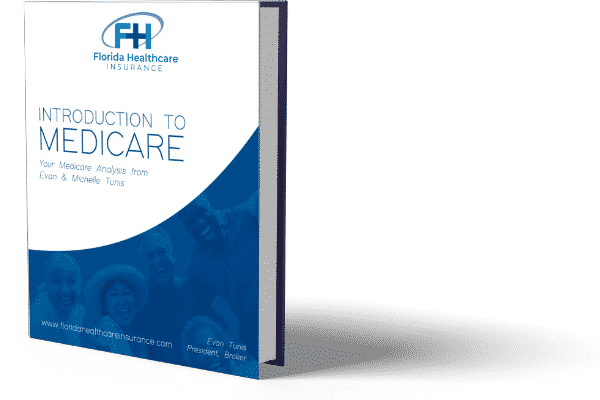Medicare Supplements
Learn More About Medicare Supplemental Insurance
Medi-Gap / Medicare Supplement Plans
Medicare Supplement (Medigap) is a plan offered by a private insurer that helps pay some of the health care costs that Original Medicare doesn’t cover, like copayments, coinsurance and deductibles.
You must be enrolled in Original Medicare (Parts A and B) to be eligible.
Should I get a Medigap plan?
For many people, the choice between these two plans comes down to price. Ask yourself questions like:
1 – Do I need the stability of a higher monthly cost with little-to-no money spent out of pocket?
2 – Can I afford to pay some costs out of pocket, as long as they are less costly and more predictable than with Medicare Part B alone?

Download Our FREE E-Book!
Introduction to Medicare
Your Medicare Analysis from Evan & Michelle Tunis

A Medigap plan might be right for you if you:
1 – Don’t mind paying a higher monthly premium but paying less—or nothing—when you get medical care.
2 – Live outside of Florida for more than a month each year and want to seek routine health services when you’re away.
3 – Don’t want to worry about staying in-network for your services to be covered, because Medigap plans don’t use networks.
4 – Don’t mind having a stand-alone Part D prescription drug plan.
How do you know if you need a Medicare Supplement Plan?
Medicare Supplement (or Medigap) insurance plans are standardized across the nation, except in Massachusetts, Minnesota, and Wisconsin. Each of the 10 plans is denoted by a letter, and the currently available plans are A, B, C, D, F, G, K, L, M, and N.
For simplicity we mainly work with Plans F, G & N.
With MediGap, you can go to any doctor or hospital nationwide who takes Medicare. There are no network restrictions. Once insured you can never be dropped due to health reasons.
Some of the gaps that Medigap plans can cover for you are:
1 – Hospital deductibles, copays and an extra 365 days in the hospital.
2 – The first 3 pints of blood as necessary in a transfusion.
3 – Outpatient deductibles, coinsurance, and excess charges.
4 – Skilled nursing coinsurance.
5 – Foreign travel emergency care.
When Should I Enroll In Medigap?
The best time to apply for a Medicare supplement is during your open enrollment window. This window runs for six months from the effective date of your Medicare Part B, or when you turn 65, whichever is later. During this window, the insurance company cannot deny you coverage for any health reason, nor can they raise their rates just on you due to any health conditions.
Some people choose to delay their enrollment into Medicare because they have other creditable coverage such as employer group health insurance. For these individuals, their 6-month Medigap open enrollment window will begin later one whenever they enroll in Part B, which is usually when they retire.
Medigap plans also come with some very attractive features like no networks, low deductibles, and the freedom to access any provider that accepts Medicare. No referrals, no paperwork from one provider to the next. They offer predictable and comprehensive coverage. Another major difference between MA-PD and Medigap plans is that Medigap plans don’t change year to year and there are no yearly maximum out of pocket costs for the health portion. Pretty good, right? Medigap plans are also guaranteed renewable — which means the insurance company cannot raise your rates or drop your coverage should any health conditions develop.These plans are perfect for those who travel frequently or embrace the “Snowbird” lifestyle. It’s also well suited for those who have serious health conditions or those who have a lot of medical usage. Based on these benefits, Medigap sounds like the way to go, right?
Well, before you jump right into a Medigap plan, there are also some things to consider:
One of the down sides of having such great coverage with a Medigap plan is that you’ll pay more for it. Premiums are usually much higher than Medicare Advantage plans because of its extensive coverage. Medigap plans also don’t come with drug coverage (Part D); they are purchased separately, called a “standalone Part D plan”. They go alongside your medical plan, and gives you an opportunity to best select your plan based on your medication needs. However, If you like the convenience of presenting only one card at your pharmacy, then Medicare Advantage plans may be best for you.
Every year Medicare raises the deductibles and co-pays for which you are responsible for. Your medical plans help to pay for these things for you, and the cost of healthcare also experiences inflation like everything else, so it’s customary for Meidgap plans to experience rate increases from year to year. With most carriers, this rate will occur once a year on your policy anniversary, and depending on when it happens is where one of our expert agents comes in. We will compare your policy to see if other carriers offer the same plan for less.
Medicare Plan G
For those eligible for Medicare after January 1, 2020 plan G is likely the best Medicare Supplement available to you.
Plan G covers ALL the holes in Part A and all of Part B with the exception of the annual deductible($203 for 2021). This includes skilled nursing, daily hospital copays, Excess Charges and even provides a Foreign Travel Emergency!
Medicare Plan N
PLAN N is used primarily for price savings!
It is considered statistically the most stable on prices across the board. However, there are some differences in Plan N that need to be understood:
The biggest thing with Plan N is it does not cover Excess charges. Excess charges are fees above the Medicare-approved payment schedule. A doctor has the option to charge up to 15% ABOVE the Medicare-approved payment schedule. These excess charges are passed on to the patient and billed directly to you after the fact.
Currently these states prohibit excess charges: Connecticut, Massachusetts, Minnesota, New York, Ohio, Pennsylvania, Rhode Island and Vermont.
1 – Plan covers 100% of the hospitalizations associated with Medicare Part A and covers the 20% completely. Similar to Plan G it does not cover the Part B deductible.
2 – Copay for a primary care/specialist of up to $20.
3 – Emergency Room copay of $50.
Medicare Advantage / Part C
What is Medicare Advantage? Medicare Advantage Plans combine Medicare Part A, Part B, and often Part D into one plan with a network of providers.
Part C of Medicare is also referred to as Medicare Advantage and the plans that you elect to fulfill this role are called Medicare advantage PLANS, MAPDS. These plans are complex so we will simplify this for you.
Remember that the primary benefit to Medicare Advantage plan is a lower cost option to a Medicare Supplement. Plans will usually have a deductible and a max out of pocket.
PPO Plans
This is perhaps the most common type of plan. PPO means Preferred Provider Organization. With these plans, you have reduced cost-sharing when you use a Preferred Provider or member of the PPO network. PPO plans typically have extra benefits like dental, vision, hearing etc. PPO plans normally include drug coverage.
HMO
HMO is probably the second most common Medicare Advantage Plan type. HMO’s means Health Maintenance Organization. With these plans, you have an assigned Primary Care Provider and they have to refer you to the doctors, hospitals, labs and specialists within the network to receive benefits.
With an HMO you may have lower copays, deductibles, coinsurance, and other cost-sharing parameters as well as EXTRA BENEFITS like Dental, Vision, Hearing, Rides to Doctors, Chiropractic Visits, and Over the Counter Benefits.
Medigap vs. Medicare Advantage
Both Medicare Advantage and Medigap are supplemental options to your Original Medicare plan. Medicare Advantage plans work similar to an individual or employer HMO or PPO plan, helping lower out-of-pocket costs with predictable copayments, smaller deductibles and out-of-pocket costs. You can also save money with a Medicare Advantage plan by seeing a doctor within the plan’s network.
On the other hand, Medigap plans work with your Original Medicare to help pay for most or all of your out-of-pocket costs that Original Medicare doesn’t cover, like copayments, coinsurance and deductibles. Medigap plans also give you more flexibility when it comes to doctor choice, because you can go to anyone who accepts Medicare.
You’ll have higher monthly premiums but pay less (or nothing) when you receive care. Unlike Medicare Advantage plans, Medigap plans do not include prescription drug coverage—you have to purchase a separate Part D plan.
It’s important to remember that these two plans do not work together. If you have a Medicare Advantage policy, you cannot enroll in a Medigap plan—and vice versa.
Medicare Part D (Prescription Coverage)
Prescription Drug Coverage
Part D is your prescription drug coverage, but it can be one of the most confusing and cost prohibitive parts of coverage for Medicare. There are four phases of coverage within Part D: Deductible, Initial Coverage Level, Coverage Gap AKA The Donut Hole, and the Catastrophic Phase!
The Initial Coverage Level… The initial coverage level is where 81% of people stay throughout the year. It’s based on where drugs fall in the formulary. Tiers 1 & 2 are usually $0 copay in this phase while Tiers 3, 4 and 5 warrant a higher copay.
The Donut Hole!!
19% of Part D beneficiaries find themselves in the Donut hole each year. This is related to a variety of high-priced drugs. When you are in the donut hole brand name medications will cost you 25% of the MSRP cost until you climb out of the donut hole.
Catastrophic Phase
At some point, people with exceptionally high-priced medications enter the Catastrophic Phase and their drugs become limited to 5% of the MSRP cost of the drugs themselves.
Part D Costs
According to CMS (Centers for Medicare & Medicaid Services), the average cost for Part D is $33.06 a month. Depending on the plan you choose your costs could be lower or higher. For Part D we use an analysis of your preferred pharmacy and will recommend the plan that covers most of our clients’ medications.
Get a FREE Medicare Quote!
Florida Medicare Experts Client Testimonials



Florida Medicare Experts Insurance Partners






